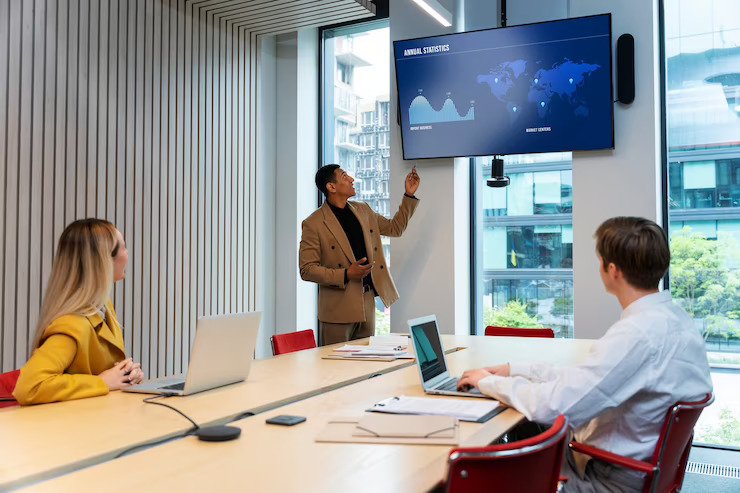The Rise Of Smart Meeting Rooms & Their Impact On Productivity

Smart offices are one of the fastest-growing workplace trends of the last few years. In 2020, the global smart office market was valued at $31.37 billion. Based on current predictions, this value is supposed to triple by 2030, when it will reach $90.63 billion.
One of the main features of smart offices is the use of smart meeting rooms. This term refers to advanced meeting spaces that are designed to enhance productivity and improve collaboration through the use of modern technologies.
Let’s focus on the main components of a smart meeting room and how they can help boost productivity in the workplace.
Main Components Of Smart Meeting Rooms
- Video conferencing solutions – These tools allow remote workers to participate in productive meetings without needing a physical presence. This is particularly important for businesses that rely on remote teams working from different locations. Video conferencing solutions also allow the sharing of visual aids (e.g., slides and documents), making it easier to collaborate by communicating information and ideas.
- Smart whiteboards – These tools make team collaboration more effective by leveraging interactive displays and collaboration software. By leveraging these whiteboards, colleagues can exchange information in online-to-offline meetings with real-time graphics and handwriting, regardless of where they are located.
- Smart sensors – These sensors can detect the presence of people in the room and provide real-time data on room availability and occupancy levels. These data can be used to make a room booking more efficient and optimize energy usage and maintenance.
- Room scheduling software – This type of software allows users and teams to book meetings and resources with extreme ease. By automating the booking and scheduling process, this software eliminates the unnecessary back-and-forth communication associated with manual booking, resulting in improved efficiency and collaboration.
- Access control solutions – These tools allow businesses to ensure that only authorized personnel can access the meeting rooms. Traditional access control measures include keypads and card or fob readers, while modern ones allow users to use digital credentials on their mobile phones to access meeting rooms.
- Security cameras – Smart meeting rooms should also be equipped with security cameras to ensure the safe and smooth execution of the meetings. Businesses can install 360 fisheye security cameras, which are particularly effective for capturing a wide-angle view of the meeting room, or they can use smart cameras that can track movement and behavior patterns in the meeting space.
Improved Engagement
By leveraging smart meeting rooms that leverage the technologies mentioned before (and others), businesses can boost their workforce’s engagement level. Rooms equipped with IoT-based cloud computing solutions, video conferencing equipment, professional audio tools, and collaboration software can create a dynamic environment that increases motivation and stimulates creativity. Your employees will be able to communicate seamlessly and share content.
Office Space Maximization
Another way smart meeting rooms can increase productivity is by maximizing office space. By leveraging smart sensors and access control solutions, businesses can ensure that their resources are used to their full potential, reducing the need for extra office space and saving a significant amount of money in the long run.
Better Cooperation Between In-Office And Remote Workers
As hinted earlier, the technologies used in smart meeting rooms allow workers to effectively interact, collaborate and share documents regardless of where they are located. This means businesses can hold productive meetings that bring together in-office and remote workers.
Video conferencing tools make the interaction simple and inclusive for all the parties involved. Moreover, integrating control panels further simplifies input control for things like presentation equipment and room lighting. Leveraging these technologies allows remote workers to participate in the company’s meetings with the same efficiency and impact as in-office workers.
Meeting Recording
Another helpful feature of smart meeting rooms is their ability to record meetings. This offers various benefits to businesses. First, it allows employees and managers to review important elements discussed during the meeting. If some workers were absent during the meeting, a recording would allow them to catch up on the issues and topics that were discussed.
Recorded footage from meetings can also be used to document the decisions that were made, the deadlines that were set, and the action items that were assigned.
Increased Automation
Another way smart meeting rooms can significantly increase productivity is by automating tasks that would otherwise require manual intervention. This can be done by leveraging automation tools, artificial intelligence, and Internet of Things devices to provide users with an intuitive, seamless, personalized experience.
Businesses can save time and effort by automating activities like setting up the meeting room and switching off lights and power tools that are not in use. Automation tools also help boost collaboration because workers do not need to spend time on mundane tasks like manually setting up their audio or video conferencing equipment.
Read Also:



























Leave A Reply